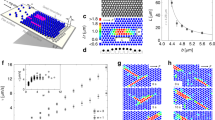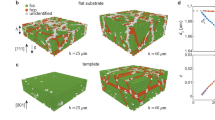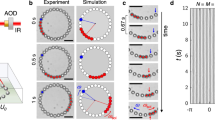Abstract
Uniform colloidal microspheres dispersed in a solvent will, under appropriate conditions, self-assemble into ordered crystalline structures1. Using these colloidal crystals as a model system, a great variety of problems of interest to materials science, physical chemistry, and condensed-matter physics have been investigated during the past two decades. Recently, it has been demonstrated2 that point defects can be created in two-dimensional colloidal crystals3 by manipulating individual particles with optical tweezers. Direct imaging of these defects verified that their stable configurations have lower symmetry than the underlying triangular lattice, as predicted by numerical simulations for a number of two-dimensional systems4,5,6,7. It was also observed that point defects can dissociate into pairs of well-separated dislocations, a topological excitation especially important in two dimensions. Here we use a similar experimental system to study the dynamics of mono- and di-vacancies in two-dimensional colloidal crystals. We see evidence that the excitation of point defects into dislocation pairs enhances the diffusion of di-vacancies. Moreover, the hopping of the defects does not follow a pure random walk, but exhibits surprising memory effects. We expect the results presented in this work to be relevant for explaining the dynamics of other two-dimensional systems.
This is a preview of subscription content, access via your institution
Access options
Subscribe to this journal
Receive 51 print issues and online access
$199.00 per year
only $3.90 per issue
Buy this article
- Purchase on Springer Link
- Instant access to full article PDF
Prices may be subject to local taxes which are calculated during checkout





Similar content being viewed by others
References
Gast, A. P. & Russel, W. B. Simple ordering in complex fluids. Phys. Today 51(12), 24–30 (1998).
Pertsinidis, A. & Ling, X. S. Equilibrium configurations and energetics of point defects in two-dimensional colloidal crystals. Phys. Rev. Lett. 87, 098303 (2001).
Murray, C. A. in Bond-Orientational Order in Condensed Matter Systems (ed. Strandburg, K. J.) Ch. 4 (Springer, New York, 1992).
Fisher, D. S., Halperin, B. I. & Morf, R. Defects in the two-dimensional electron solid and implications for melting. Phys. Rev. B 20, 4692–4712 (1979).
Cockayne, E. & Elser, V. Energetics of point defects in the two-dimensional Wigner crystal. Phys. Rev. B 43, 623–629 (1991).
Frey, E., Nelson, D. R. & Fisher, D. S. Interstitials, vacancies, and supersolid order in vortex crystals. Phys. Rev. B 49, 9723–9745 (1994).
Jain, S. & Nelson, D. R. Statistical mechanics of vacancy and interstitial strings in hexagonal columnar crystals. Phys. Rev. E 61, 1599–1615 (2000).
Ashkin, A., Dziedzic, J. M., Bjorkholm, J. E. & Chu, S. Observation of a single-beam gradient force optical trap for dielectric particles. Opt. Lett. 11, 288–290 (1986).
Crocker, J. C. & Grier, D. G. Methods of digital video microscopy for colloidal studies. J. Colloid Interf. Sci. 179, 298–310 (1996).
Acknowledgements
We thank S.C. Ying and D.A. Weitz for discussions. This work was supported by the National Science Foundation, the Petroleum Research Fund, and the Research Corporation. X.S.L. acknowledges the support of the A.P. Sloan Foundation.
Author information
Authors and Affiliations
Supplementary information
Rights and permissions
About this article
Cite this article
Pertsinidis, A., Ling, X. Diffusion of point defects in two-dimensional colloidal crystals. Nature 413, 147–150 (2001). https://doi.org/10.1038/35093077
Received:
Accepted:
Issue Date:
DOI: https://doi.org/10.1038/35093077
This article is cited by
-
Precise colloids with tunable interactions for confocal microscopy
Scientific Reports (2015)
-
Colloidal crystal grain boundary formation and motion
Scientific Reports (2014)
-
Templated in-situ synthesis of gold nanoclusters conjugated to drug target bacterial enoyl-ACP reductase, and their application to the detection of mercury ions using a test stripe
Microchimica Acta (2014)
-
Fractionalization of interstitials in curved colloidal crystals
Nature Materials (2012)
-
Breaking up in a curved plane
Nature Materials (2012)
Comments
By submitting a comment you agree to abide by our Terms and Community Guidelines. If you find something abusive or that does not comply with our terms or guidelines please flag it as inappropriate.



